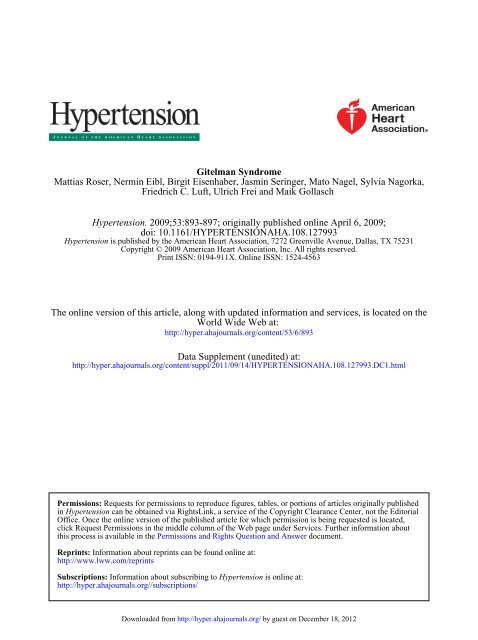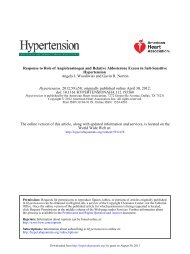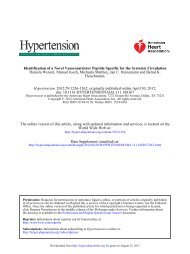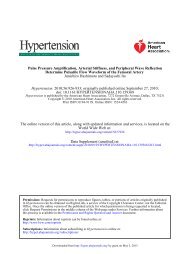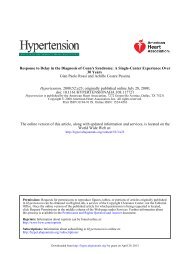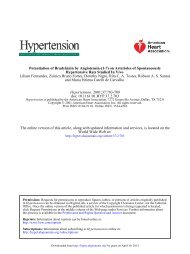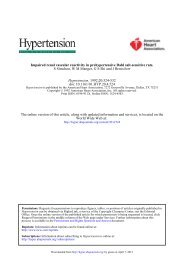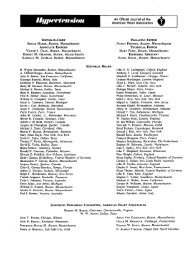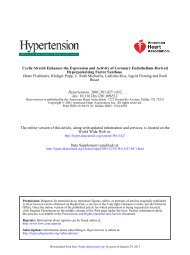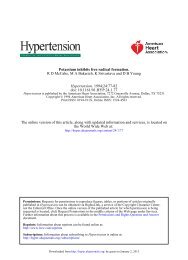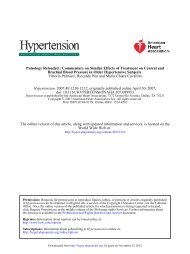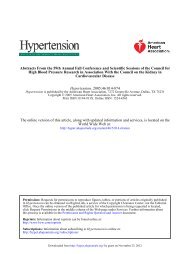Hypertension Grand Rounds - Gitelman Syndrome
Hypertension Grand Rounds - Gitelman Syndrome
Hypertension Grand Rounds - Gitelman Syndrome
Create successful ePaper yourself
Turn your PDF publications into a flip-book with our unique Google optimized e-Paper software.
<strong>Gitelman</strong> <strong>Syndrome</strong><br />
Mattias Roser, Nermin Eibl, Birgit Eisenhaber, Jasmin Seringer, Mato Nagel, Sylvia Nagorka,<br />
Friedrich C. Luft, Ulrich Frei and Maik Gollasch<br />
<strong>Hypertension</strong>. 2009;53:893-897; originally published online April 6, 2009;<br />
doi: 10.1161/HYPERTENSIONAHA.108.127993<br />
<strong>Hypertension</strong> is published by the American Heart Association, 7272 Greenville Avenue, Dallas, TX 75231<br />
Copyright © 2009 American Heart Association, Inc. All rights reserved.<br />
Print ISSN: 0194-911X. Online ISSN: 1524-4563<br />
The online version of this article, along with updated information and services, is located on the<br />
World Wide Web at:<br />
http://hyper.ahajournals.org/content/53/6/893<br />
Data Supplement (unedited) at:<br />
http://hyper.ahajournals.org/content/suppl/2011/09/14/HYPERTENSIONAHA.108.127993.DC1.html<br />
Permissions: Requests for permissions to reproduce figures, tables, or portions of articles originally published<br />
in <strong>Hypertension</strong> can be obtained via RightsLink, a service of the Copyright Clearance Center, not the Editorial<br />
Office. Once the online version of the published article for which permission is being requested is located,<br />
click Request Permissions in the middle column of the Web page under Services. Further information about<br />
this process is available in the Permissions and Rights Question and Answer document.<br />
Reprints: Information about reprints can be found online at:<br />
http://www.lww.com/reprints<br />
Subscriptions: Information about subscribing to <strong>Hypertension</strong> is online at:<br />
http://hyper.ahajournals.org//subscriptions/<br />
Downloaded from<br />
http://hyper.ahajournals.org/ by guest on December 18, 2012
<strong>Hypertension</strong> <strong>Grand</strong> <strong>Rounds</strong><br />
<strong>Gitelman</strong> <strong>Syndrome</strong><br />
Mattias Roser, Nermin Eibl, Birgit Eisenhaber, Jasmin Seringer, Mato Nagel, Sylvia Nagorka,<br />
Friedrich C. Luft, Ulrich Frei, Maik Gollasch<br />
<strong>Gitelman</strong> syndrome (GS) is an autosomal-recessive renal<br />
tubular disorder characterized by hypokalemia, hypomagnesemia,<br />
hypocalciuria, metabolic alkalosis, secondary<br />
hyperreninemic aldosteronism, and low blood pressure. 1–3 GS<br />
patients are usually diagnosed relatively late, because malaise,<br />
low blood pressure, hypokalemia, hypocalciuria, and<br />
hypomagnesemia are difficult to categorize clinically. Inactivating<br />
mutations in the SLC12A3 gene encoding the<br />
thiazide-sensitive sodium chloride cotransporter (NCCT)<br />
cause GS. 2 The investigators used the criteria of Bettinelli et<br />
al4 to identify patients with GS. More than 100 SLC12A3<br />
mutations have been described. 3 Most are missense mutations<br />
substituting conserved amino acid residues within putative<br />
functional domains of NCCT, whereas nonsense, frameshift,<br />
and splice site defects and gene rearrangements are less<br />
frequent. GS is clinically variable (men are more severely<br />
affected than women), and the combination of mutations<br />
present in each allele may determine phenotype variability. 3<br />
A heterozygous carrier state for 30 different inactivating<br />
mutations in NCCT, as well as genes responsible for Bartter<br />
syndrome, is associated with reduced blood pressure risk of<br />
hypertension in the general population. 5 Approximately 80%<br />
of the mutation carriers had systolic blood pressure values<br />
below the mean of the entire 5124-subject cohort of the<br />
Framingham Heart Study. The mean blood pressure reduction<br />
in carriers averaged �6.3 mm Hg for the systolic and<br />
�3.4 mm Hg for the diastolic blood pressures, similar to<br />
values obtained with chronic thiazide treatment. There was a<br />
60% reduction in the risk of developing hypertension by age<br />
60 years. Thus, rare alleles that affect renal salt handling and<br />
blood pressure in the general population could account for a<br />
substantial fraction of blood pressure variation. 5 We encountered<br />
2 patients and then found others in our database who<br />
illustrate the importance of NCCT on blood pressure variability<br />
and, therefore, hypertension.<br />
The Patients<br />
A 29-year-old man presented with a 14-year history of<br />
generalized weakness, severe muscle cramps with tetany,<br />
dyspnea, and anxiety. He had visited emergency departments<br />
on earlier occasions and received potassium and/or magnesium<br />
infusions for hypokalemia and hypomagnesemia. His<br />
symptoms had progressed to the point that he could no longer<br />
drive a car or use public transport. The patient denied nausea,<br />
vomiting, diarrhea, heat intolerance, excessive perspiration,<br />
and changes in bowel habits. He ingested no laxatives or<br />
diuretics, nor did he abuse alcohol or street drugs. His other<br />
clinical symptoms included fatigue, heart palpitations, dizziness,<br />
nocturia, polydipsia, polyuria, and thirst.<br />
The blood pressure was 100/60 mm Hg, and heart rate was<br />
90 bpm. There were no neurological findings or proximal<br />
muscle weaknesses. Imaging studies were unremarkable, as<br />
was the ECG. Laboratory tests showed hypokalemia<br />
(3.0 mmol/L) and hypomagnesemia (0.69 mmol/L), whereas<br />
serum calcium, sodium, and chloride levels were normal. The<br />
creatinine clearance was 134 mL/min per 1.73 m 2 . Urinary<br />
calcium excretion (1.0 mmol/24 hours) was decreased,<br />
whereas the urinary potassium and magnesium excretion<br />
were elevated (106 mmol/24 hours and 6.82 mmol/24 hours)<br />
in the face of his low serum values. The plasma renin<br />
concentration was elevated (172 ng/mL) while supine and<br />
increased (302 ng/mL) with standing. The corresponding<br />
plasma aldosterone levels were normal to mildly increased<br />
(120 ng/mL supine and 217 ng/mL standing). The 24-hour<br />
urinary sodium excretion was 141, 176, and 350 mmol/24<br />
hours on 3 consecutive days on an ad libitum intake. Arterial<br />
blood gases were pH 7.49, PCO 2 41.6 mm Hg, and HCO 3 �<br />
31.6 mmol/L.<br />
The parents and an older brother were asymptomatic,<br />
whereas his younger brother had similar, albeit less severe,<br />
symptoms. We sequenced the exons and flanking regions of<br />
SLC12A3 after written informed consent was given and found<br />
3 mutations in exons 10, 13, and 16. The patient and his<br />
brother were compound heterozygous, having inherited<br />
Phe548Leu and Pro643Leu from their mother and Gly439Ser<br />
from their father (please see Table S1 in the online data<br />
supplement at http://hyper.ahajournals.org). The Phe548Leu<br />
mutation has not been reported earlier and is localized in a<br />
transmembrane region (Figure). The highly conserved phenylalanine<br />
is exchanged for a leucine (Figure S1). Gly439Ser<br />
Received December 15, 2008; first decision January 6, 2009; revision accepted March 17, 2009.<br />
From the Division of Nephrology and Intensive Care Medicine (M.R., N.E., J.S., U.F., M.G.), Department of Medicine, Charité Campus Virchow,<br />
Berlin, Germany; Experimental Therapeutics Centre and Bioinformatics Institute, Agency for Science, Technology and Research (B.E.), Singapore;<br />
Experimental and Clinical Research Center and HELIOS Klinikum-Berlin (F.C.L., M.G.), Berlin, Germany; and the Center for Nephrology and Metabolic<br />
Disorders (M.N., S.N.), Weißwasser, Germany.<br />
Correspondence to Maik Gollasch, Charité-Universitätsmedizin Berlin, Campus Virchow-Klinikum, Nephrology/Intensive Care Medicine, Augustenburger<br />
Platz 1, D-13353 Berlin, Germany. E-mail maik.gollasch@charite.de<br />
(<strong>Hypertension</strong>. 2009;53:893-897.)<br />
© 2009 American Heart Association, Inc.<br />
<strong>Hypertension</strong> is available at http://hyper.ahajournals.org DOI: 10.1161/HYPERTENSIONAHA.108.127993<br />
Downloaded from<br />
http://hyper.ahajournals.org/ 893 by guest on December 18, 2012
894 <strong>Hypertension</strong> June 2009<br />
Extracellular Space<br />
N<br />
Trp161Xaa<br />
c.104delCinsTT<br />
Phe548Leu<br />
c.1927delC<br />
Gly770Asp<br />
Cytoplasm Gly841Arg Gln1012Arg<br />
and Pro643Leu have been reported previously in heterozygous<br />
GS patients 6 but not in this allelic combination. 7<br />
Although Gly439Ser and Pro643Leu would be sufficient to<br />
account for the symptoms in our patient, the presence of 3<br />
mutations (Gly439Ser and Pro643Leu/Phe548Leu) is the<br />
possible reason that his symptoms were remarkably severe.<br />
The patient was given oral magnesium and potassium<br />
supplementation (18 and 84 mmol/d, respectively). His serum<br />
potassium and magnesium levels improved to low-normal<br />
values, and his clinical symptoms improved. Magnesium and<br />
potassium supplementations in combination with antialdosterone<br />
medications, prostaglandin inhibitors, or angiotensinconverting<br />
enzyme inhibitors have been advocated. 8–10 Aldosterone<br />
antagonists or epithelial sodium channel blockers can<br />
be considered if symptomatic hypokalemia is not corrected<br />
by MgCl 2 administration. 11 A potential concern of using these<br />
drugs in patients with GS is that the salt wasting might<br />
worsen, especially if dietary salt intake is reduced or when<br />
salt is lost from the body through a nonrenal mechanism.<br />
Even high doses of the epithelial sodium channel blocker<br />
amiloride may fail to curtail the excessive kaliuresis in<br />
patients with GS. 1 Low concentrations of these drugs in the<br />
lumen of the cortical collecting duct and modulation of the<br />
distal tubular potassium channel (renal outer medullary potassium<br />
channel) conductance could be responsible. 12 Amiloride<br />
is, as such, problematic, because it seems to increase<br />
aldosterone production accompanied by insufficient stimulation<br />
of plasma renin activity. The authors invoke a rise in<br />
serum potassium as an explanation. 13<br />
Spironolactone and angiotensin-converting enzyme inhibitors<br />
had been given empirically to our patient earlier by his<br />
family doctors. Both drugs were stopped after 1 month each<br />
because of dizziness, probably as result of low blood pressure<br />
episodes. Amiloride was also tried. However, the patient<br />
discontinued this medication because of unexplained neck<br />
pain. We tried a course of aliskiren 150 mg/d to inhibit<br />
angiotensin-mediated aldosterone release; however, the aldosterone<br />
values did not decrease, and the metabolic alkalosis<br />
did not improve. Currently, the patient can tolerate his<br />
symptoms, in part because he now has a greater understanding<br />
of his disease.<br />
A 21-year-old woman presented with blurred vision,<br />
cramps, tongue discomfort, and fatigue. At age 11 years, she<br />
observed that eating bananas made her feel better. She had<br />
never been brought to an emergency department, was physically<br />
active, and was employed. Her general practitioner was<br />
Ser987Arg<br />
C<br />
Figure. Domain architecture and positions<br />
of mutations in SLC12A3 detected in the<br />
present study.<br />
concerned about severe hypokalemia and hypomagnesemia.<br />
She denied nausea, vomiting, diarrhea, heat intolerance,<br />
excessive perspiration, and changes in bowel habits. She had<br />
no history of laxatives or diuretic abuse, nor did she abuse<br />
alcohol or street drugs. She denied nocturia, polydipsia,<br />
polyuria, and thirst.<br />
The blood pressure was 115/80 mm Hg; heart rate was 85<br />
bpm. The physical examination was normal. She had hypokalemia<br />
(2.8 mmol/L) and hypomagnesemia (0.48 mmol/L),<br />
whereas serum calcium, sodium, chloride, creatinine levels<br />
were normal. The creatinine clearance was 122 mL/min per<br />
1.73 m 2 . Urinary excretion of calcium (0.37 mmol/24 hours)<br />
was decreased, whereas urinary excretion of potassium and<br />
magnesium (67.00 and 2.83 mmol/24 hours, respectively)<br />
were elevated in the face of her serum values. The urinary<br />
24-hour excretion of sodium was 145 mmol with an ad<br />
libitum intake. She also had a compensated metabolic alkalosis<br />
(pH 7.46, PCO 2 44.8 mm Hg, and HCO 3 � 31.0 mmol/L).<br />
Her parents were clinically unremarkable, whereas her 19year-old<br />
brother described similar general weakness and<br />
muscle cramps, although less frequent.<br />
With her approval, we again sequenced the exons and<br />
flanking introns of SLC12A3 and found a mutation in exon 26<br />
(Gln1012Arg), as well as a deletion of exon 1, codon 35<br />
(c.104delCinsTT). Our patient is compound heterozygous,<br />
having inherited c.104delCinsTT from her mother and<br />
Gln1012Arg from her father (please see Table S1).<br />
Gln1012Arg is a novel missense mutation (Figure) that<br />
affects a sequence position at which the glutamine is conserved<br />
throughout all vertebrates (Table S1). Because<br />
SLC12A3 codes for 1021 amino acids, Gln1012Arg is located<br />
in close proximity to the C-terminal end of the protein<br />
sequence. This variant is located in the most distal part of the<br />
C-terminal SCL12A3 cytoplasmic domain known to date.<br />
Analysis of our clinically suspected GS patient databank<br />
revealed no other subjects with Gln1012Arg. However, we<br />
did find 6 additional new SLC12A3 gene mutations in other<br />
subjects (Gly841Arg, Ser987Arg, c.1927delC, Trp161Xaa,<br />
Gly770Asp, and IVS25�1G�T; Figure and Table S1). In<br />
these subjects, the referring nephrologists or geneticists had<br />
suspected GS on the basis of clinical examination and<br />
laboratory tests. Family histories and medical charts were<br />
reviewed and showed clinical features consistent with GS.<br />
We treated this patient with oral magnesium and potassium<br />
supplementation (2.8 and 40.0 mmol/d). In addition, her local<br />
nephrologists prescribed ramipril 2.5 mg/d. Serum potassium<br />
Downloaded from<br />
http://hyper.ahajournals.org/ by guest on December 18, 2012
and magnesium levels reached low-normal values, and clinical<br />
symptoms improved significantly but did not resolve<br />
completely. Oral magnesium supplementation was, therefore,<br />
increased, and clinical symptoms improved. However, restoration<br />
of normal magnesium and potassium values was<br />
difficult and was accompanied by nausea and diarrhea.<br />
Magnesium aspartate was replaced with magnesium chloride,<br />
which was more tolerable.<br />
Discussion<br />
Nephrologists are generally confronted with hypertension.<br />
However, a thorough knowledge of hypotensive syndromes,<br />
particularly GS, is important not only for clinical reasons but<br />
also to understand the complex genetics of blood pressure<br />
regulation in the general population. During a routine nephrology<br />
ward rotation, we discovered novel SLC12A3 mutations<br />
in 2 symptomatic GS patients (Phe548Leu,<br />
Gln1012Arg, and c.104delCinsTT). These results caused us<br />
to work up our databank of “suspicious” hypokalemic hypomagnesemic<br />
patients, and, again, we were successful. We<br />
found 6 other new SLC12A3 gene mutations (Gly841Arg,<br />
Ser987Arg, c.1927delC, Trp161Xaa, Gly770Asp, and<br />
IVS25�1G�T). We elected to move genetic analysis from<br />
the research laboratory to the routine clinical arena for several<br />
reasons. First, a precise diagnosis permits a more exact,<br />
goal-directed clinical care. Second, we learned that our<br />
patients wanted desperately to know specifically what was<br />
wrong and what the relevance could be for their current and<br />
future families. Our patients did not raise concerns about fear<br />
of privacy violations, higher insurance premiums, or similar<br />
concerns.<br />
Decreased reabsorption of sodium at the NCCT and subsequent<br />
increased potassium losses via the renal outer medullary<br />
potassium channel, largely driven by secondary aldosteronism,<br />
explain the hypokalemia and reportedly increased<br />
salt appetite in GS patients. The hypocalciuria and hypermagnesuria<br />
are more difficult to understand. Nijenhuis et al 14<br />
argued that enhanced passive calcium transport in the proximal<br />
tubule, rather than active calcium transport in distal<br />
convolution, explains thiazide-induced hypocalciuria. Their<br />
micropuncture experiments in mice demonstrated increased<br />
reabsorption of sodium and calcium in the proximal tubule<br />
during chronic thiazide treatment, whereas calcium reabsorption<br />
in the distal convolution appeared unaffected. Furthermore,<br />
thiazide administration still induced hypocalciuria in<br />
transient receptor potential channel subfamily V, member 5<br />
gene-deleted mice, in which active distal calcium reabsorption<br />
was abolished because of inactivation of the epithelial<br />
calcium channel TRPV5. Next, Nijenhuis et al 14 found that<br />
thiazide upregulated the sodium/proton exchanger, responsible<br />
for the majority of sodium and, consequently, calcium<br />
reabsorption in the proximal tubule, whereas the expression<br />
of proteins involved in active calcium transport was unaltered.<br />
The authors then performed experiments addressing the<br />
time-dependent effect of a single thiazide dose and showed<br />
that the development of hypocalciuria paralleled a compensatory<br />
increase in sodium reabsorption secondary to an initial<br />
natriuresis. Finally, hypomagnesemia developed during<br />
chronic thiazide administration and in NCCT gene-deleted<br />
Roser et al <strong>Gitelman</strong> <strong>Syndrome</strong> 895<br />
mice, accompanied by downregulation of the epithelial magnesium<br />
channel transient receptor potential channel subfamily<br />
M, member 6. Transient receptor potential channel subfamily<br />
M member 6 downregulation could represent a general<br />
mechanism involved in the pathogenesis of hypomagnesemia<br />
accompanying NCCT inhibition or inactivation. 14<br />
Human studies have also been performed. Cheng et al 15<br />
investigated 8 GS patients and 8 control subjects. Isotonic<br />
saline (3 L) over 3 hours was given. Baseline sodium<br />
excretion and creatinine clearance rates were similar in GS<br />
patients and controls, although calcium excretion rate was<br />
lower in GS patients. In GS patients, saline infusion caused a<br />
significantly greater sodium excretion rate than in controls,<br />
but there was only a small increase in the calcium excretion<br />
rate in both the first 6 hours and the subsequent 18 hours. The<br />
authors concluded that hypovolemia is not the sole cause of<br />
hypocalciuria in patients with GS. However, their clinical<br />
study had several deficits. Long-term sodium balance was not<br />
controlled in the subjects, and the GS patients likely had a<br />
reduced extracellular circulating volume under both control<br />
and expansion conditions compared with controls.<br />
Our patients illustrate the difficulties in managing GS. The<br />
tubular defect in GS itself cannot be corrected so that<br />
adequate supplementation of magnesium and potassium remains<br />
the cornerstone of treatment. However, restoration of<br />
normal magnesium and potassium values is difficult to<br />
achieve, because high doses of magnesium cause diarrhea.<br />
The bioavailability of magnesium preparations is variable.<br />
Magnesium oxide and magnesium sulfate have a significantly<br />
lower bioavailability compared with magnesium chloride,<br />
magnesium lactate, and magnesium aspartate. 11 We recommend<br />
administration of magnesium chloride orally to compensate<br />
for renal magnesium and chloride losses. Although<br />
antialdosterone therapy has been reported to increase plasma<br />
potassium and magnesium levels and to reduce the fractional<br />
excretion of potassium and magnesium in GS patients, 10 the<br />
role of inhibiting the renin-angiotensin-aldosterone system in<br />
GS patients is not clear. Estrogens seem to play a role because<br />
drospirenone, a novel progestogen developed for use as<br />
hormone therapy in postmenopausal women, in combination<br />
with 17�-estradiol, has a potassium-sparing effect that counteracts<br />
thiazide-induced potassium loss. 16 Future studies on<br />
NCCT-deficient mice might be helpful to understand the role<br />
of these systems in GS. NCCT-deficient mice on a mixed<br />
background have been shown to exhibit hypocalciuria and<br />
hypomagnesemia but no potassium and acid-base homeostasis<br />
disturbances. 17 NCCT-deficient mice backcrossed onto<br />
the C57BL/6 background showed mild compensated alkalosis<br />
with increased levels of plasma aldosterone 18 and an increased<br />
sensitivity to develop hypokalemia when exposed to<br />
reductions in dietary potassium. 19 These studies underscore<br />
the importance of the genetic background for the NCCTdeficient<br />
phenotype, which is also potentially relevant for<br />
understanding phenotypic variability and development of<br />
pharmacological treatments in GS. To date, there are no data<br />
about the effectiveness of renin and/or angiotensinconverting<br />
enzyme inhibition in GS available. Future studies<br />
on NCCT mice might help to clarify this issue.<br />
Downloaded from<br />
http://hyper.ahajournals.org/ by guest on December 18, 2012
896 <strong>Hypertension</strong> June 2009<br />
Finally, we learned in the course of our study that mutations<br />
such as these have a distinct bearing on the complex<br />
genetics of hypertension in the general population. We could<br />
not conduct a study on GS prevalence. Our patient population<br />
is heterogeneous and generally of German, Turkish, or<br />
Middle Eastern background. The mutations reported here<br />
were all in German white subjects. Hsu et al 20 studied 500<br />
unrelated children from Taipei. They found 15 SLC12A3<br />
mutations in 10 of the children. In a 1852-subject Japanese<br />
study, GS mutations were encountered in 3.2% of subjects. 21<br />
The literature would suggest that GS is not rare and GS<br />
heterozygosity certainly not that uncommon. Knowledge of<br />
novel mutations might also be important for determining<br />
alleles with health benefits that are nonetheless under purifying<br />
selection and for defining the genetic architecture of<br />
hypertension. 5 In this respect, combined effects of rare<br />
independent mutations have been suggested to account for a<br />
substantial fraction of blood pressure variation in the population<br />
on the basis of analyzing the impact of the heterozygous<br />
carrier state for a limited number of inactivating<br />
mutations in the NCCT, sodium-potassium 2-chloride cotransporter,<br />
and renal outer medullary potassium channel. 22<br />
Recently, members of the Framingham Heart Study were<br />
screened for variation in 3 genes, namely, SLC12A3,<br />
SLC12A1, and KCNJ1. The investigators used comparative<br />
genomics, genetics, and biochemistry to identify subjects<br />
with mutations proven or inferred to be functional. These<br />
mutations were all heterozygous and rare but were found in<br />
�1% to 2% of the Framingham population. 5 They produced<br />
clinically significant blood pressure reductions and presumably<br />
protected the individuals from development of hypertension.<br />
These findings and the mutations we report here have<br />
implications for the genetic studies on hypertension and other<br />
common complex traits. Carriers of mutations causing GS<br />
compensate for renal salt wasting by increasing their salt<br />
intake, as shown in a large Amish kindred. 23 In agreement, we<br />
found that urinary 24-hour sodium excretion was high in the<br />
first patient probably because of increased salt appetite.<br />
However, the increased urinary sodium excretion in carriers<br />
of the mutations causing GS versus wild-type relatives was<br />
not reflected by significant blood pressure changes in adults<br />
of the above mentioned large Amish kindred with GS. 23 In<br />
contrast, another study showed that carriers of mutations<br />
causing GS had lower blood pressure values than controls,<br />
however, with similar urinary sodium excretion. 24 Notably,<br />
our second patient showed normal urinary 24-hour sodium<br />
excretion; however, she was a small, slight woman. For her<br />
size, her salt intake was generous. NCCT-deficient mice have<br />
no salt-losing phenotype on a regular diet, 17 and compensatory<br />
mechanisms for the loss of NCCT have been documented<br />
in various mouse models. 25 Finally, NCCT stands out<br />
as a target of with-no-lysine kinase (WNK) regulation, as<br />
discussed recently in a scholarly review. 26 The mirror image<br />
of GS is pseudohypoaldosteronism type II (PHAII), which is<br />
also called Gordon syndrome. PHAII features high blood<br />
pressure, hyperkalemia, and metabolic acidosis. All of the<br />
metabolic aberrancies in PHAII are corrected by thiazide<br />
diuretics, which recapitulate the features of GS. WNK4 and<br />
WNK1 mutations cause PHAII. WNK4 inhibits NCCT, an<br />
effect that is lost when WNK4 is mutated. WNK1 phosphorylates<br />
WNK4, which diminishes the WNK4 inhibition of<br />
NCCT. A gain-of-function WNK1 mutation causes PHAII.<br />
The WNKs also influence the renal outer medullary potassium<br />
channel and epithelial sodium channel. The findings that<br />
altered levels of WNK1 and WNK4 function influence blood<br />
pressure in humans are relevant because WNK4 lies only 1<br />
Mb from locus D17S1299, the site showing the strongest<br />
linkage to blood pressure variation in the Framingham Heart<br />
Study population. Variants that alter WNK function would of<br />
course also influence the GS phenotype in persons harboring<br />
NCCT mutations.<br />
Source of Funding<br />
This study was supported by the Deutsche Forschungsgemeinschaft.<br />
None.<br />
Disclosures<br />
References<br />
1. <strong>Gitelman</strong> HJ, Graham JB, Welt LG. A new familial disorder characterized<br />
by hypokalemia and hypomagnesemia. Trans Assoc Am Physicians.<br />
1966;79:221–235.<br />
2. Simon DB, Nelson-Williams C, Bia MJ, Ellison D, Karet FE, Molina<br />
AM, Vaara I, Iwata F, Cushner HM, Koolen M, Gainza FJ, Gitleman HJ,<br />
Lifton RP. <strong>Gitelman</strong>’s variant of Bartter’s syndrome, inherited<br />
hypokalaemic alkalosis, is caused by mutations in the thiazide-sensitive<br />
Na-Cl cotransporter. Nat Genet. 1996;12:24–30.<br />
3. Riveira-Munoz E, Chang Q, Bindels RJ, Devuyst O. <strong>Gitelman</strong>’s syndrome:<br />
towards genotype-phenotype correlations? Pediatr Nephrol.<br />
2007;22:326–332.<br />
4. Bettinelli A, Bianchetti MG, Girardin E, Caringella A, Cecconi M,<br />
Appiani AC, Pavanello L, Gastaldi R, Isimbaldi C, Lama G, Marchesoni<br />
C, Matteucci C, Pierluigi P, DiNatale B, Setzu C, Vitucci P. Use of<br />
calcium excretion values to distinguish two forms of primary renal<br />
tubular hypokalemic alkalosis: Bartter and <strong>Gitelman</strong> syndromes.<br />
J Pediatr. 1992;120:38–43.<br />
5. Ji W, Foo JN, O’Roak BJ, Zhao H, Larson MG, Simon DB, Newton-Cheh<br />
C, State MW, Levy D, Lifton RP. Rare independent mutations in renal<br />
salt handling genes contribute to blood pressure variation. Nat Genet.<br />
2008;40:592–599.<br />
6. Mastroianni N, Bettinelli A, Bianchetti M, Colussi G, De Fusco M, Sereni<br />
F, Ballabio A, Casari G. Novel molecular variants of the Na-Cl cotransporter<br />
gene are responsible for <strong>Gitelman</strong> syndrome. Am J Hum Genet.<br />
1996;59:1019–1026.<br />
7. Cruz DN, Shaer AJ, Bia MJ, Lifton RP, Simon DB. <strong>Gitelman</strong>’s syndrome<br />
revisited: an evaluation of symptoms and health-related quality of life.<br />
Kidney Int. 2001;59:710–717.<br />
8. Yang GQ, Zhao L, Xi WQ, Mu YM, Dou JT, Lu JM. A clinical analysis<br />
of 9 cases of <strong>Gitelman</strong> syndrome [in Chinese]. Zhonghua Nei Ke Za Zhi.<br />
2006;45:650–653.<br />
9. Mayan H, Gurevitz O, Farfel Z. Successful treatment by cyclooxyenase-2<br />
inhibitor of refractory hypokalemia in a patient with <strong>Gitelman</strong>’s<br />
syndrome. Clin Nephrol. 2002;58:73–76.<br />
10. Colussi G, Rombola G, De Ferrari ME, Macaluso M, Minetti L. Correction<br />
of hypokalemia with antialdosterone therapy in <strong>Gitelman</strong>’s<br />
syndrome. Am J Nephrol. 1994;14:127–135.<br />
11. Knoers NV, Levtchenko EN. <strong>Gitelman</strong> syndrome. Orphanet J Rare Dis.<br />
2008;3:22.<br />
12. Kamel KS, Oh MS, Halperin ML. Bartter’s, <strong>Gitelman</strong>’s, and Gordon’s<br />
syndromes. From physiology to molecular biology and back, yet still<br />
some unanswered questions. Nephron. 2002;92(suppl 1):18–27.<br />
13. Bull MB, Laragh JH. Amiloride: a potassium-sparing natriuretic agent.<br />
Circulation. 1968;37:45–53.<br />
14. Nijenhuis T, Vallon V, van der Kemp AW, Loffing J, Hoenderop JG,<br />
Bindels RJ. Enhanced passive Ca2� reabsorption and reduced Mg2�<br />
channel abundance explains thiazide-induced hypocalciuria and hypomagnesemia.<br />
J Clin Invest. 2005;115:1651–1658.<br />
Downloaded from<br />
http://hyper.ahajournals.org/ by guest on December 18, 2012
15. Cheng CJ, Shiang JC, Hsu YJ, Yang SS, Lin SH. Hypocalciuria in<br />
patients with <strong>Gitelman</strong> syndrome: role of blood volume. Am J Kidney Dis.<br />
2007;49:693–700.<br />
16. Preston RA, Norris PM, Alonso AB, Ni P, Hanes V, Karara AH. Randomized,<br />
placebo-controlled trial of the effects of drospirenone-estradiol<br />
on blood pressure and potassium balance in hypertensive postmenopausal<br />
women receiving hydrochlorothiazide. Menopause. 2007;14:408–414.<br />
17. Schultheis PJ, Lorenz JN, Meneton P, Nieman ML, Riddle TM, Flagella<br />
M, Duffy JJ, Doetschman T, Miller ML, Shull GE. Phenotype resembling<br />
<strong>Gitelman</strong>’s syndrome in mice lacking the apical Na�-Cl-cotransporter of<br />
the distal convoluted tubule. J Biol Chem. 1998;273:29150–29155.<br />
18. Loffing J, Vallon V, Loffing-Cueni D, Aregger F, Richter K, Pietri L,<br />
Bloch-Faure M, Hoenderop JG, Shull GE, Meneton P, Kaissling B.<br />
Altered renal distal tubule structure and renal Na(�) and Ca(2�)<br />
handling in a mouse model for <strong>Gitelman</strong>’s syndrome. J Am Soc Nephrol.<br />
2004;15:2276–2288.<br />
19. Morris RG, Hoorn EJ, Knepper MA. Hypokalemia in a mouse model of<br />
<strong>Gitelman</strong>’s syndrome. Am J Physiol Renal Physiol. 2006;290:<br />
F1416–F1420.<br />
20. Hsu YJ, Yang SS, Chu NF, Sytwu HK, Cheng CJ, Lin SH. Heterozygous<br />
mutations of the sodium chloride cotransporter in Chinese children:<br />
Roser et al <strong>Gitelman</strong> <strong>Syndrome</strong> 897<br />
prevalence and association with blood pressure. Nephrol Dial Transplant.<br />
2009;24:1170–1175.<br />
21. Tago N, Kokubo Y, Inamoto N, Naraba H, Tomoike H, Iwai N. A high<br />
prevalence of <strong>Gitelman</strong>’s syndrome mutations in Japanese. Hypertens<br />
Res. 2004;27:327–331.<br />
22. Devuyst O. Salt wasting and blood pressure. Nat Genet. 2008;40:495–496.<br />
23. Cruz DN, Simon DB, Nelson-Williams C, Farhi A, Finberg K, Burleson<br />
L, Gill JR, Lifton RP. Mutations in the Na-Cl cotransporter reduce blood<br />
pressure in humans. <strong>Hypertension</strong>. 2001;37:1458–1464.<br />
24. Fava C, Montagnana M, Rosberg L, Burri P, Almgren P, Jonsson A,<br />
Wanby P, Lippi G, Minuz P, Hulthen LU, Aurell M, Melander O.<br />
Subjects heterozygous for genetic loss of function of the thiazidesensitive<br />
cotransporter have reduced blood pressure. Hum Mol Genet.<br />
2008;17:413–418.<br />
25. Belge H, Gailly P, Schwaller B, Loffing J, Debaix H, Riveira-Munoz E,<br />
Beauwens R, Devogelaer JP, Hoenderop JG, Bindels RJ, Devuyst O.<br />
Renal expression of parvalbumin is critical for NaCl handling and<br />
response to diuretics. Proc Natl Acad Sci U S A. 2007;104:14849–14854.<br />
26. Kahle KT, Ring AM, Lifton RP. Molecular physiology of the WNK<br />
kinases. Annu Rev Physiol. 2008;70:329–355.<br />
Downloaded from<br />
http://hyper.ahajournals.org/ by guest on December 18, 2012
Online Supplement<br />
<strong>Gitelman</strong> syndrome<br />
Mattias Roser,* Nermin Eibl,* Birgit Eisenhaber, & Jasmin Seringer,* Mato Nagel, § Sylvia<br />
Nagorka, § Friedrich C. Luft, # Ulrich Frei,* Maik Gollasch* #<br />
*Department of Medicine, Division of Nephrology and Intensive Care Medicine, Charité<br />
Campus Virchow, 13353 Berlin, & Experimental Therapeutic Centre, Singapore 138669,<br />
# Experimental and Clinical Research Center and HELIOS Klinikum-Berlin, 13125 Berlin, and<br />
§ Center for Nephrology and Metabolic Disorders, 02943 Weißwasser, Germany<br />
Short title: <strong>Gitelman</strong> <strong>Syndrome</strong><br />
Correspondence and offprint requests to:<br />
Maik Gollasch, MD, PhD<br />
Charité - Universitätsmedizin Berlin<br />
Campus Virchow-Klinikum, Nephrology / Intensive Care Medicine<br />
Augustenburger Platz 1<br />
D-13353 Berlin, Germany<br />
Phone: (+49) 30 450 653263<br />
Fax: (+49) 30 450 553909<br />
maik.gollasch@charite.de<br />
Downloaded from<br />
http://hyper.ahajournals.org/ by guest on December 18, 2012
Supplementary Material Table S1. Patients with GS mutations.<br />
Patient DNA Sequence<br />
Mutation<br />
Deduced<br />
Protein<br />
Modification<br />
Homozygous Reference<br />
1 NM_001126108.1:c.1315G>A p.Gly439Ser - Mastroianni,<br />
Am J Gen<br />
1996<br />
NM_001126108.1:c.1644C>G p.Phe548Leu - Present<br />
study *<br />
NM_001126108.1:c.1928C>T p.Pro643Leu - Cruz,<br />
Kidney<br />
2001<br />
Int<br />
2 NM_001126108.1:c.104delCinsTT p.Ala35fs - Present<br />
study †<br />
NM_001126108.1:c.3035A>G p.Gln1012Arg - Present<br />
study *<br />
3 ‡ NM_001126108.1:c.482G>A p.Trp161X - Present<br />
study §<br />
NM_001126108.1:c.2549T>C p.Leu850Pro - Simon, Nat<br />
Gen 1996<br />
4 NM_001126108.1:c.2221G>A p.Gly741Arg - Simon, Nat<br />
Gen 1996<br />
NM_001126108.1:c.1927delC p.Pro643fs - Present<br />
study ||<br />
Downloaded from<br />
http://hyper.ahajournals.org/ by guest on December 18, 2012<br />
3
5 ‡ NM_001126108.1:c.2309G>A p.Gly770Asp - Present<br />
study *<br />
NM_001126108.1:c.2953+1G>T<br />
(IVS25+1G>T )<br />
- Present<br />
study<br />
6 NM_001126108.1:c.2521G>C p.Gly841Arg + Present<br />
study *<br />
7 NM_001126108.1:c.1315G>A p.Gly439Ser - Mastroianni,<br />
Am J Gen<br />
1996<br />
NM_001126108.1:c.2961C>G p.Ser987Arg - Present<br />
study *<br />
The following mutations have been described previously, but not in this allelic combination.<br />
Patient DNA Sequence Mutation Deduced<br />
Protein<br />
Modification<br />
Homozygous Reference<br />
8 NM_001126108.1:c.1315G>A p.Gly439Ser - Mastroianni,<br />
Am J Gen<br />
1996<br />
NM_001126108.1:c.2660G>A p.Arg887Gln - Kurschat,<br />
DMW 2003<br />
9 NM_001126108.1:c.1049C>T p.Ser350Leu + Riveira-<br />
Munoz,<br />
Downloaded from<br />
http://hyper.ahajournals.org/ by guest on December 18, 2012<br />
4
JASN 2007,<br />
heterozygote<br />
10 NM_001126108.1:c.941C>T p.Ser314Phe - Reissinger,<br />
Kidney<br />
Blood Press<br />
Res 2002<br />
NM_001126108.1:c.2954G>A p.Cys985Tyr - Syren, Hum<br />
Mutat 2002<br />
11 NM_001126108.1:c.1964G>A p.Arg655His - Simon, Nat<br />
Gen 1996<br />
NM_001126108.1:c.2885+1G>T<br />
(IVS24+1G>T)<br />
- Simon, Nat<br />
Gen 1996<br />
All positions of the detected mutations are indicated with respect to SLC12A3 gene (GeneID:<br />
6559) isoform3 (NM_001126108.1), the respective protein sequence is S12A3_HUMAN<br />
(accession number P55017) which is 9 amino acids shorter in comparison to isoform1<br />
(NP_000330.2) due to the usage of an alternate in-frame splice site in the 3’ coding region.<br />
As a consequence, some of the identifiers of mutations (with a localization between sequence<br />
position 807 and the C-terminus) that originally have been annotated in agreement with the<br />
longer sequence version (isoform1) have been adapted to the Uniprot sequence version<br />
(isoform3). For example the mutation c.2521G>C (p.Gly841Arg) was originally annotated as<br />
c.2548G>C (p.Gly850Arg) for the longer sequence.<br />
Downloaded from<br />
http://hyper.ahajournals.org/ by guest on December 18, 2012<br />
5
* In all of these missense mutations, an amino acid that is strongly conserved at the respective<br />
sequence position within vertebrates (supplemental material, sequence alignment, figure S1)<br />
is substituted by another amino acid.<br />
† This insertion is predicted to be fatal. The normal sequence is<br />
103 GCTGCCTATGAC…<br />
35 -A--A--Y--D-…<br />
which is predicted to change to<br />
103 GTTTGCCTATGA…<br />
35 -V--C--L--X-<br />
containing TGA as a stop codon.<br />
‡U.S. American family<br />
§ The stop codon TAG is predicted to prematurely terminate protein translation in exon 3 at<br />
position 161. This will lead to a truncated transcript and protein product.<br />
|| As a result of a frameshift, the normal sequence.<br />
1921 TACCGC CCC CAGTGC…<br />
641 -Y--R- -P- -Q--C-…<br />
is predicted to change to<br />
1921 TACCGC CCC AGT GCC…<br />
641 -Y--R- -P- -S- -A-…<br />
Since exon 16 starts with proline, at least this exon will be affected.<br />
Turkish families.<br />
Downloaded from<br />
http://hyper.ahajournals.org/ by guest on December 18, 2012<br />
6
Page 1 of 3<br />
Supplemental Figure S1: Multiple sequence alignment of SLC12A3 proteins<br />
. . : **:*:* * *:.*:*: *. : **:* :* : : . ** ****.:***:*<br />
Hs|gi|1717801|sp|P55017.1|S12A3_HUMAN MAELPTTETPGDATLCSGRFTISTLLSSDEPSPPAAYDSSHPSHLTHSSTFCMRT----FGYNTIDVVPTYEHYANSTQPGEPRKVRPTLADLHSFLKQEGRHLHALAFDSRPSHEMTDG-LVEGEAGTSSEKNPEEPVRFGWVKGVMIR 145<br />
Pt|gi|114662622|ref|XP_001138088.1| MAELTTTETPGDATLCSGRFTISTLLSSDEPSPPAAYDSSHPSHLTHSSTFCMRT----FGYNTIDVVPAYEHYANSTQPGEPRKVRPTLADLHSFLKQEGRHLHALAFDSRPSHEMTDG-LVEGEAGTSSEKNPEEPVRFGWVKGVMIR 145<br />
Pa|gi|197098766|ref|NP_001125490.1| MAELPTTETPGDATLCSGRFTISTLLSSDEPSPPAAYDSSHPSHLTHGSTFCMRT----FGYNTIDVVPAYEHYANSTQPGEPRKVRPTLADLHSFLK-EGRHLHALALDSRPSHEMTDG-LVEDEAGTSSEKNPEEPVRFGWVKGVMIR 144<br />
Ma|gi|109128597|ref|XP_001093467.1| MAELPSTETPGDATLCSGRFTISTLLSSDEPSPPAACDSSHPSHLTHGSTFCMRT----FGYNTIDVVPAYEHYANSTQPGEPRKVRPTLADLHSFLKQEGRHLHALAFDSRPSHEMTDG-LVEDEAGTSSEKNPEEPVRFGWVKGVMIR 145<br />
Ec|gi|194208620|ref|XP_001493476.2| MAELPVSETPGDPALCSGRFTISTLLGGDEPPQPAAYDSSHPSHLTHGSTFYMRT----FGYNTIDVVPAYEHYANSALPGEPRKVRPTLADLHSFLKQEGSHLHALAFDSRPGHEMTDG-LVEDEAGTGGEKSPAEPVRFGWVKGVMIR 145<br />
Bt|gi|119910063|ref|XP_871112.2| MAELPVSEAPRDPALCSGRFTISTLLGGEEPPPPAAYDSSHPSHLTHGNTFYNRT----FGYNTIDVVPAYEHYANSALPGEPRKVRPTLADLHSFLKQEGSHLHALAFDSRPSHEMTDG-LVEDEAGINGEKNPEEPVRFGWVKGVMIR 145<br />
Cf|gi|73950363|ref|XP_535292.2| MAELPVSEMPGDPALCSGRFIISTLLGGDEPPPPAACDSSHPSHLTHGSTFYMRT----FGYNTIDVVPAYEHYANSALPGEPRKVRPTLADLHSFLKQEGSHLHALAFDTRPSHEMTDG-LVEDEAGTNSEKQPGEPVRFGWVKGVMIR 145<br />
Mm|gi|27151683|sp|P59158.1|S12A3_MOUSE MAELPVTELPGD-ALCSGRFTISTLMGGDEP-PPAACDSSQPSHLTHGSTLYMRT----FGYNTIDVVPAYEHYANSALPGEPRKVRPTLADLHSFLKQEGSHLHALAFDGRQGRELTDG-LVEDETGTNSEKSPGEPVRFGWVKGVMIR 143<br />
Rn|gi|27151789|sp|P55018.2|S12A3_RAT MAELPVTEMPGD-ALCSGRFTISTLLGGDEP-PPAACDNSQPSHLTHGSTLYLRT----FGYNTIDVVPAYEHYANSALPGEPRKVRPTLADLHSFLKQEGSHLHALAFDGRPGHELTDG-LVEDETGANSEKSPGEPVRFGWVKGVMIR 143<br />
Oc|gi|130505142|ref|NP_001076118.1| MAELPASETPGDPALCSGRFTISTLLVGDEPPPSAAYDGSHASHVTLGSSLYMRT----FGYNTIDVVPAYEHYANSTLPGEPRKLRPTLADLHSFLK-EGSPLHVLALDSRPSHEMTDG-LVEDEAGAGGEK-PGEPVRFGWVKGVMIR 143<br />
Gg|gi|118096212|ref|XP_414059.2| -MEVPFLQEAAG---CEG-----TQLS--------------------GSSLCTRT----FGYNTVDVVPAYEHYANSRGVGEAGRGRPSLADLHSILKPDPGHLRVPLPDPQRSNGLPD---AEEGAGEPSSAPAAEPVRFGWVKGVMIR 114<br />
Ss|gi|76445912|gb|ABA42822.1| --MEEVPAAPNEGISLSALRSQFSVNGEEGPKYGFDGNRYH--YGDGTSVASQNSTQILTGYDTLDVGPNYDFYANTNAQGRVRRSRPSLFQLHSNIEEDSCPPPLYEETNTGRAPG----DSSEEDVE---EPQSEPTRFGWVKGVMVR 139<br />
Om|gi|76445922|gb|ABA42831.1| --MEEVPAAPNEGISLSALRSQFSVNGEEGPKYGFDGSRYH--YGDGTSVASQNSSQILTGYDTLDVGPNYDFYANTNALGRVRRSRPSLFQLHSNIEEDSCPPPLYEETNTGRAPG----DSSEDDVE---EPQSEPTRFGWVKGVMIR 139<br />
Ps|gi|1717802|sp|P55019.1|S12A3_PSEAM ---MELPGDGVHLASYGPRAPQLAVNG-KAPAGGLDGSGYYQCYRDGSSVASRGS-DAPTGYDTVDAPPHYDFYANTEVWGRRRRVRPSLYQLSVDPEQDDFKPPMYEETAGERMGGG---DSSEEEEEEHKEPPPEPPRFGWVQGVMIR 142<br />
DR|gi|113682309|ref|NP_001038545.1| ----------MNLQSARSPFSVSSLSNGDDRKFSLGGCSSY----DTDSVASRSS-GVFSGYDTLDAPPSYDFYTNTEVFGRAKKSRPSLFELHSNPQDDPSPPPLYEESSVD--------KQSPEDEDEPTEPPPEPARFGWAQGVMIR 127<br />
Aa|gi|84619346|emb|CAD92102.1| -MADVPPIETVKMTSFNKQLKVPPAGSDESYARYLYDNSKDGTYHSNGEANSQSS-APFSGYDTLDEAPNYDFYANTVVRGKVRKSRPSLFQLQSVLEEDSSPPPLYEEANRAAHGGINGEDSSEDEGE--MEPEVEPTRFGWVQGVMIR 146<br />
1.......10........20........30........40........50........60........70........80........90.......100.......110.......120.......130.......140.......150<br />
*********************** ***:**::* :* ***** ***:***:**.*************:*********:*****.************ *:.* :** *****:**::** **.**:******:***::**:**::<br />
Hs|gi|1717801|sp|P55017.1|S12A3_HUMAN CMLNIWGVILYLRLPWITAQAGIVLTWIIILLSVTVTSITGLSISAISTNGKVKSGGTYFLISRSLGPELGGSIGLIFAFANAVGVAMHTVGFAETVRDLLQEYGAPIVDPINDIRIIGVVSVTVLLAISLAGMEWESKAQVLFFLVIMV 295<br />
Pt|gi|114662622|ref|XP_001138088.1| CMLNIWGVILYLRLPWITAQAGIVLTWIIILLSVTVTSITGLSISAISTNGKVKSGGTYFLISRSLGPELGGSIGLIFAFANAVGVAMHTVGFAETVRDLLQEYGAPIVDPINDIRIIGVVSVTVLLAISLAGMEWESKAQVLFFLVIMV 295<br />
Pa|gi|197098766|ref|NP_001125490.1| CMLNIWGVILYLRLPWITAQAGIVLTWIIILLSVTVTSITGLSISAISTNGKVKSGGTYFLISRSLGPELGGSIGLIFAFANAVGVAMHTVGFAETVRDLLQEYGAPIVDPINDIRIIGVVSVTVLLAISLAGMEWESKAQVLFFLVIMV 294<br />
Ma|gi|109128597|ref|XP_001093467.1| CMLNIWGVILYLRLPWITAQAGIVLTWIIILLSVTVTSITGLSISAISTNGKVKSGGTYFLISRSLGPELGGSIGLIFAFANAVGVAMHTVGFAETVRDLLQEYGAPIVDPINDIRIIGVVSVTVLLAISLAGMEWESKAQVLFFLVIMV 295<br />
Ec|gi|194208620|ref|XP_001493476.2| CMLNIWGVILYLRLPWITAQAGIVLTWIIILLSVTVTSITGLSISAISTNGKVKSGGTYFLISRSLGPELGGSIGLIFAFANAVGVAMHTVGFAETVRDLIQEHGAPIVDPINDIRIIGVVTVTVLLGISLAGMEWESKAQVLFFLVIMV 295<br />
Bt|gi|119910063|ref|XP_871112.2| CMLNIWGVILYLRLPWITAQAGIVLTWIIILLSVTVTSITGLSISAISTNGKVKSGGTYFLISRSLGPELGGSIGLIFAFANAVGVAMHTVGFAETVRDLLQEYGSPIVDPTNDIRIIGVVTVTVLLAISLAGMEWESKAQVLFFLVIMV 295<br />
Cf|gi|73950363|ref|XP_535292.2| CMLNIWGVILYLRLPWITAQAGIVLTWIIILLSVTVTSITGLSISAISTNGRVKSGGTYFLISRSLGPELGGSIGLIFAFANAVGVAMHTVGFAETVRDLLQEHGTPIVDPINDIRIIGVVTVTVLLAISLAGMEWESKAQVLFFLVIMV 295<br />
Mm|gi|27151683|sp|P59158.1|S12A3_MOUSE CMLNIWGVILYLRLPWITAQAGIVLTWLIILLSVMVTSITGLSISAISTNGKVKSGGTYFLISRSLGPELGGSIGLIFAFANAVGVAMHTVGFAETVRDLLQEYGTPIVDPINDIRIIGVVTVTVLLAISLAGMEWESKAQVLFFLVIMV 293<br />
Rn|gi|27151789|sp|P55018.2|S12A3_RAT CMLNIWGVILYLRLPWITAQAGIVLTWLIILLSVMVTSITGLSISAISTNGKVKSGGTYFLISRSLGPELGGSIGLIFAFANAVGVAMHTVGFAETVRDLLQENGTPIVDPINDIRIIGVVTVTVLLAISLAGMEWESKAQVLFFLVIMV 293<br />
Oc|gi|130505142|ref|NP_001076118.1| CMLNIWGVILYLRLPWITAQAGIVLTWVIILLSVLVTSITGLSISAISTNGKVKSGGTYFLISRSLGPELGGSIGLIFSFANAVGVAMHTVGFAETVRDLLQEYGTPIVDPINDIRIIGVVTVTVLLAISLAGMEWESKAQVLFFLVIMV 293<br />
Gg|gi|118096212|ref|XP_414059.2| CMLNIWGVILYLRLPWITAQAGIALTWLIILMSVTVTTITGLSISAISTNGKVKSGGTYFLISRSLGPELGGSIGLIFAFANAVAVAMHTVGFAETVRDLLQEHNSLIVDPTNDIRIIGVLTVTVLLGISLAGMEWEAKAQILFFLVILV 264<br />
Ss|gi|76445912|gb|ABA42822.1|<br />
Om|gi|76445922|gb|ABA42831.1|<br />
CMLNIWGVILYLRLPWITAQAGIGLTWVIILLSSCITGITGLSTSAIATNGRVKGGGTYFLISRSLGPKLGGSIGLIFAFANAVAVAMHTVGFAETVQALMEESGASIVDPINDIRIIGVITVTCLLAISLAGMEWEAKAQVLFFFVILV 289<br />
CMLNIWGVILYLRLPWITAQAGIGLTWVIILLSSCITGITGLSTSAIATNGRVKGGGTYFLISRSLGPELGGSIGLIFAFANAVAVAMHTVGFAETVQALMQESGASIVDPINDIRIIGVITVTCLLAISLAGMEWEAKAQVLFFIVILV 289<br />
Ps|gi|1717802|sp|P55019.1|S12A3_PSEAM CMLNIWGVILYLRLPWITAQAGIGLTWVIILLSSFITGITGLSTSAIATNGKVKGGGTYFLISRSLGPELGGSIGLIFAFANAVAVAMHTVGFAETVTDLMRENGVVMVDPINDIRIVGVITVTCLLGISMAGMEWESKAQVLFFLVIMV 292<br />
DR|gi|113682309|ref|NP_001038545.1| CMLNIWGVILYLRLPWITAQAGIGLTWIIILVSSSITGITGLSTSAIATNGKVKGGGTYFLISRSLGPELGGSIGLIFAFANAVAVAMHTVGFAETVQVLMQETEVSMVDKLNDIRIIGVITVTCLLAISMAGMEWESKAQVLFFFVIMI 277<br />
Aa|gi|84619346|emb|CAD92102.1| CMLNIWGVILYLRLPWITAQAGIGLTWVIIILSSCITGITGLSTSAIATNGKVKGGGTYFLISRSLGPELGGSIGLIFAFANAVAVAMHTVGFAETVQSLMQESGASMVDPINDIRIIGVITVTCLLGISLAGMEWESKAQVIFFLVIMI 296<br />
.......160.......170.......180.......190.......200.......210.......220.......230.......240.......250.......260.......270.......280.......290.......300<br />
** .*: **:**.: :* ::**:** :.:**. *:** *** :*.***:*********************:** :***:**::******:*** :::**.:*::***** :**:: * *:.* * *:*:.* .<br />
Hs|gi|1717801|sp|P55017.1|S12A3_HUMAN SFANYLVGTLIPPSEDKASKGFFSY---------RADIFVQNLVPDWRGPDGTFFGMFSIFFPSATGILAGANISGDLKDPAIAIPKGTLMAIFWTTISYLAISATIGSCVVRDASGVLNDTVTPGW--GACEGLACSYGWNFTECTQQH 434<br />
Pt|gi|114662622|ref|XP_001138088.1| SFANYLVGTLIPPSEDKASKGFFSY---------RADIFVQNLVPDWRGPDGTFFGMFSIFFPSATGILAGANISGDLKDPAIAIPKGTLMAIFWTTISYLAISATIGSCVVRDASGVLNDTVTPGW--GACEGLACSYGWNFTECTQQQ 434<br />
Pa|gi|197098766|ref|NP_001125490.1| SFANYLAGTLIPPSEDKASKGFFSY---------RADIFVQNLVPDWRGPDGTFFGMFSIFFPSATGILAGANISGDLKDPAIAIPKGTLMAIFWTTISYLAISATIGSCVVRDASGVLNDTVTPGW--GACEGLACSYGWNFTECTQQH 433<br />
Ma|gi|109128597|ref|XP_001093467.1| SFANYLVGTLIPPSEDKASKGFFSY---------RADIFVQNLVPDWRGPDGTFFGMFSIFFPSATGILAGANISGDLKDPAVAIPKGTLMAIFWTTISYLAISATIGSCMVRDASGVLNDTVTPGW--GACEGLACGYGWNFTECTQQH 434<br />
Ec|gi|194208620|ref|XP_001493476.2| SFANYLVGTLIPPSEDKASKGFFSY---------RGDIFVQNLVPDWRGVDGSFFGMFSIFFPSATGILAGANISGDLRDPAVAIPKGTLMAIFWTTVSYLAISATIGSCVVRDASGDLNDTMTPGS--GACEGLACGYGWNFTHCSQQH 434<br />
Bt|gi|119910063|ref|XP_871112.2| SFANYLVGTLIPPSEEKASKGFFSY---------RADIFVQNLVPEWRGMDGSFFGMFSIFFPSATGILAGANISGDLKDPAVAIPKGTLMAIFWTTVSYLAISATIGSCVVRDASGGLNDTVTPGS--GACEGLACGYGWNFTECAQQR 434<br />
Cf|gi|73950363|ref|XP_535292.2| SFANYLVGTLIPPSEDKASKGFFSY---------RGDIFVQNLVPDWRGADGSFFGMFSIFFPSATGILAGANISGDLKDPAVAIPKGTLMAIFWTTVSYLAISATIGSCVVRDASGVLNDTVTAGS--GACEGLACGYGWNFTECAHQG 434<br />
Mm|gi|27151683|sp|P59158.1|S12A3_MOUSE SFANYLVGTLIPASEDKASKGFYSY---------HGDIFVQNLVPDWRGIDGSFFGMFSIFFPSATGILAGANISGDLKDPAVAIPKGTLMAIFWTTISYLAISATIGSCVVRDASGDVNDTMTPGP--GPCEGLACGYGWNFTECSQQR 432<br />
Rn|gi|27151789|sp|P55018.2|S12A3_RAT SFANYLVGTLIPASKDKASKGFYSY---------HGDIFVQNLVPDWRGIDGSFFGMFSIFFPSATGILAGANISGDLKDPAVAIPKGTLMAIFWTTISYLAISATIGSCVVRDASGDVNDTITPGP--GLCEGLACGYGWNFTECSQQH 432<br />
Oc|gi|130505142|ref|NP_001076118.1| SFTNYLVGTLIPPSEDKASKGFFSY---------RGDIFVQNLVPDWRGVDGSFFGMFSIFFPSATGILAGANISGDLKDPAVAIPKGTLMAIFWTTVSYLAISATIGACVVRDASGNLNDTVTPGL--GACEGLACGYGWNFTECAQRH 432<br />
Gg|gi|118096212|ref|XP_414059.2| SFINYLVGTVIPASAEKQAKGFFSY---------RADIFAQNFVPDWRGPEGSFFGLFSIFFPSATGILAGANISGDLKDPALAIPKGTLMAIFWTTVSYLVLSATIGACVLRDASGSLNDSVAVGS--PGCEGLGCSYGWNFTDCAQRQ 403<br />
Ss|gi|76445912|gb|ABA42822.1| SFANYIVGTIIPATPQKQAKGFFSY---------QADIFAENFVPGWRGPEGNFFGMFSIFFPSATGILAGANISGDLKDPTVAIPRGTLMAIFWTTLSYLIIAATIGACMVRDASGIMNDTLVMSS-ADSCQGLACQYGWDFTNCITNR 429<br />
Om|gi|76445922|gb|ABA42831.1| SFANYIVGTIIPATPQKQAKGFFSYQGQSSMAFRQSDIFAENFVPNWRGPEGNFFGMFSIFFPSATGILAGANISGDLKDPTVAIPRGTLMAIFWTTLSYLIIAATIGACLVRDASGIMNDTLAMSS-ADSCQGLACQYGWDFTDCITNR 438<br />
Ps|gi|1717802|sp|P55019.1|S12A3_PSEAM SFVNYIVGTIIPASPQKQAKGFFSY---------KAEIFAANFVPGWRGKEGSFFGMFSIFFPSATGILAGANISGDLKDPTVAIPRGTLMAIFWTTISYLIISATIGACVVRDASGELNDTLSYSSSSENCSGLACQYRWDFSECIKNN 433<br />
DR|gi|113682309|ref|NP_001038545.1| SFASYIIGTIIPATPQKQARGFFSY---------RADIFATNFVPGWRGPEGSFFGMFSIFFPSATGILAGANISGDLKDPNVAIPRGTMLAIFWTTVSYLIISATIGSCVVRDASGDVNDTISSLT--GECLGVGCNYGWNFTDCMTNN 416<br />
Aa|gi|84619346|emb|CAD92102.1| SFVNYFVGTVIPATPQKQARGFFSY---------RADIFAANFVPQWRGPDGSFFGMFSIFFPSATGILAGANISGDLRDPAVAIPRGTLMAIFWTTMSYLLISSTIASCVLRDASGSMNDSVPISD-TGNCVGLGCRYGWDFSECTNNK 436<br />
.......310.......320.......330.......340.......350.......360.......370.......380.......390.......400.......410.......420.......430.......440.......450<br />
by guest on December 18, 2012<br />
http://hyper.ahajournals.org/<br />
Downloaded from
Page 2 of 3<br />
Roser M. et al.: Multiple sequence alignment of SLC12A3 proteins<br />
:* .*: * **:**:**...***:******************.******* *.*** **:*.** *** **:*.*:*:: **: *::*****:************************:********:*::*.** :*:*: .::*****<br />
Hs|gi|1717801|sp|P55017.1|S12A3_HUMAN SCHYGLINYYQTMSMVSGFAPLITAGIFGATLSSALACLVSAAKVFQCLCEDQLYPLIGFFGKGYGKNKEPVRGYLLAYAIAVAFIIIAELNTIAPIISNFFLCSYALINFSCFHASITNSPGWRPSFQYYNKWAALFGAIISVVIMFLL 584<br />
Pt|gi|114662622|ref|XP_001138088.1| SCHYGLINYYQTMSMVSGFAPLITAGIFGATLSSALACLVSAAKVFQCLCEDQLYPLIGFFGKGYGKNKEPVRGYLLAYAIAVAFIIIAELNTIAPIISNFFLCSYALINFSCFHASITNSPGWRPSFQYYNKWAALFGAIISVVIMFLL 584<br />
Pa|gi|197098766|ref|NP_001125490.1| SCHYGLINYYQTMSMVSGFAPLITAGIFGATLSSALACLVSAAKVFQCLCKDQLYPLIGFFGKGYGKNKEPVRGYLLAHAIAVAFIIIAELNTIAPIISNFFLCSYALINFSCFHASITNSPGWRPSFQYYNKWAALFGAIISMVIMFLL 583<br />
Ma|gi|109128597|ref|XP_001093467.1| SCRYGLINYYQTMSMVSGFAPLITAGIFGATLSSALACLVSAAKVFQCLCKDQLYPLIGFFGKGYGKNKEPVRGYLLAYAIAVAFIVIAELNTIAPIISNFFLCSYALINFSCFHASITNSPGWRPSFQYYNKWAALFGAIISVVIMFLL 584<br />
Ec|gi|194208620|ref|XP_001493476.2| SCRYGLINYYQSMSMVSGFAPLITAGIFGATLSSALACLVSAAKVFQCLCVDQLYPLIGFFGKGYGKNNEPVRGYLLAYAIAVAFIIIAELNTIAPIISNFFLCSYALINFSCFHASITNSPGWRPSFRYYSKWAALFGAVISVVIMFLL 584<br />
Bt|gi|119910063|ref|XP_871112.2| SCRYGLINYYQTMSMVSGFAPLITAGIFGATLSSALACLVSAAKVFQCLCLDQLYPLIGFFGKGYGKNNEPVRGYLLAYAIAVAFIIIAELNTIAPIISNFFLCSYALINFSCFHASITNSPGWRPSFRYYSKWAALFGAIISVVIMFLL 584<br />
Cf|gi|73950363|ref|XP_535292.2| SCRYGLINYYQTMSMVSGFAPLITAGIFGATLSSALACLVSAAKVFQCLCQDQLYPLIGFFGKGYGKNKEPVRGYLLAYAIAVAFIIIAELNTIAPIISNFFLCSYALINFSCFHASITNSPGWRPSFRYYSKWSALFGAVISVVIMFLL 584<br />
Mm|gi|27151683|sp|P59158.1|S12A3_MOUSE SCRYGLINYYQTMSMVSAFAPLITAGIFGATLSSALACLVSAAKVFQCLCEDQLYPLIGFFGKGYGKNREPVRGYLLAYAIAVAFIIIAELNTIAPIISNFFLCSYALINFSCFHASITNSPGWRPSFRYYSKWAALFGAVISVVIMFLL 582<br />
Rn|gi|27151789|sp|P55018.2|S12A3_RAT SCRYGLINYYQTMSMVSAFAPLITAGIFGATLSSALACLVSAAKVFQCLCEDQLYPLIGFFGKGYGKNKEPVRGYLLAYAIAVAFIIIAELNTIAPIISNFFLCSYALINFSCFHASITNSPGWRPSFRYYSKWAALFGAVISVVIMFLL 582<br />
Oc|gi|130505142|ref|NP_001076118.1| SCRYGLINYYQTMSMVSGFAPLITAGIFGATLSSALACLVSAAKVFQCLCEDQLYPLIGFFGKGYGKNNEPVRGYLLAYAIAVAFIIIAELNTIAPIISNFFLCSYALINFSCFHASITNSPGWRPSFRYYSKWSALFGAVVSVVIMFLL 582<br />
Gg|gi|118096212|ref|XP_414059.2| SCRYGLSNYYQSMSMVSGFGPLITAGIFGATLSSALACLVSAPKVFQCLCKDQLYPLIGFFGKGYGKNSEPIRGYMLTYAIAIGFILIAELNAIAPIISNFFLCSYALINFSCFHASITNSPGWRPSFRYYSKWAALFGATISVVIMFLL 553<br />
Ss|gi|76445912|gb|ABA42822.1| TCTYGLSNQYQSMSLVSGFAPLITAGIFGATLSSALACLVSAPKVFQCLCKDNLYPVIGFFGKGNGKNDEPIRGYVLAYIIAVCFVLIAELNTIAPIISNFFLCSYALINFSCFHASITNSPGWRPSFRFYSKWMSLLGAVVSVIIMFLL 579<br />
Om|gi|76445922|gb|ABA42831.1| TCTYGLSNQYQSMSLVSGFAPLITAGIFGATLSSALACLVSAPKVFQCLCKDNLYPVIGFFGKGNGKNDEPIRGYVLAYIIAVCFVLIAELNTIAPIISNFFLCSYALINFSCFHASITNSPGWRPSFRFYSKWMSLLGAVVSVIIMFLL 588<br />
Ps|gi|1717802|sp|P55019.1|S12A3_PSEAM TCKHGIMNYYQSMSLVSAFAPLISAGIFGATLSSALACLVSAPKVFQCLCKDQLYPLIGFFGKGYGKNAEPLRAYLLTYVIAVCFVLIAELNTIAPIISNFFLCSYALINFSCFHASVTNSPGWRPSFRFYSKWLSLLGAVCCVVIMFLL 583<br />
DR|gi|113682309|ref|NP_001038545.1| TCTYGLSNYYQSMSMVSAVAPLITAGIFGATLSSALACLVSAPKVFQCLCKDKLYPGIGFFGKGYGKNNEPLRSYLLAYIIAICFILIAELNTIAPIISNFFLCSYALINFSCFHASITNSPGWRPTFRFYSKWLSLLGAVVSVIIMFLL 566<br />
Aa|gi|84619346|emb|CAD92102.1| TCAFGISNYYQSMSMVSGFAPLIAAGIFGATLSSALACLVSAPKVFQCLCKDRLYPFIGIFAKGYGKNDEPIRGYVLTYVIAICFILIAELNTIAPIISNFFLCSYALINFSCFHASITNSPGWRPSFRYYSKWLSLLGSVVSVIIMFLL 586<br />
.......460.......470.......480.......490.......500.......510.......520.......530.......540.......550.......560.......570.......580.......590.......600<br />
********:*:::*** *.:**:* ******:**.**. **. ...*. *::*:**********:*** **:***::. :*:. ***:*.:*: . . :. * ** :*::::** * * *** **: *::.:***:::<br />
Hs|gi|1717801|sp|P55017.1|S12A3_HUMAN TWWAALIAIGVVLFLLLYVIYKKPEVNWGSSVQAGSYNLALSYSVGLNEVEDHIKNYRPQCLVLTGPPNFRPALVDFVGTFTRNLSLMICGHVLIGPHKQRMPELQLIANGHTKWLNKRKIKAFYSDVIAEDLRRGVQILMQAAGLGRMK 734<br />
Pt|gi|114662622|ref|XP_001138088.1| TWWAALIAIGVVLFLLLYVIYKKPEVNWGSSVQAGSYNLALSYSVGLNEVEDHIKNYRPQCLVLTGPPNFRPALVDFVGTFTRNLSLMICGHVLIGPHKQRMPELQLIANGHTKWLNKRKIKAFYSDVIAEDLRRGVQILMKAAGLGRMK 734<br />
Pa|gi|197098766|ref|NP_001125490.1| TWWAALIAIGVVLFLLLYVIYKKPEVNWGSSVQAGSYNLALSYSAGLNEVEDHIKNYRPQCLVLTGPPNFRPALVDFVGTFTRNLSLMICGHVLIGPHKQRMPELQLIANGHTKWLKKRKIKAFYSDVIAEDLRRGVQILMQAAGLGRMK 733<br />
Ma|gi|109128597|ref|XP_001093467.1| TWWAALIAIGVVLFLLLYVIYKKPEVNWGSSVQAGSYNLALSYSVGLNEVEDHIKNYRPQCLVLTGPPNFRPALVDFVGTFTRNLSLMICGHVLIGPHKQRMPELQLIASGHTKWLNKRKIKAFYSDVIAEDLRKGVQILMQASGLGRMK 734<br />
Ec|gi|194208620|ref|XP_001493476.2| TWWAALIAIGVVLFLLLYVIYKKPEVNWGSSVQAGSYNLALSSSVGLNEVEDHIKNYRPQCLVLTGPPNFRPALVDFVGTFTRNLSLMICGHVLVGPRKQRMPELRLIANGHTKWLNKRKIKAFYSDVIAEDLRSGVQILMQAAGLGRMK 734<br />
Bt|gi|119910063|ref|XP_871112.2| TWWAALIAIGVVLFLLLYVIYKKPEVNWGSSVQAGSYNLALSYSVGLNEVEDHIKNYRPQCLVLTGPPNFRPALVDFVGTFTRNLSLMICGHVLMGPRKQRMPELRLIANGHTKWLNKRKIKAFYSDVLAEDLRSGVQVLMQAAGLGRMK 734<br />
Cf|gi|73950363|ref|XP_535292.2| TWWAALIAIGVVLFLLLYVIYKKPDVNWGSSVQAGSYNLALSYSVGLNEVEDHIKNYRPQCLVLTGPPNFRPALVDFVGTFTRNLSLMICGHVLIGPRKQRMPELRLIANGHTKWLNKRKIKAFYSDVIAEDLRSGVQILMQAAGLGRMK 734<br />
Mm|gi|27151683|sp|P59158.1|S12A3_MOUSE TWWAALIAIGVVLFLLLYVIYKKPEVNWGSSVQAGSYNLALSYSVGLNEVEDHIKNYRPQCLVLTGPPNFRPALVDFVSTFTQNLSLMICGHVLIGPGKQRVPELRLIASGHTKWLNKRKIKAFYSDVIAEDLRSGVQILMQASGLGRMK 732<br />
Rn|gi|27151789|sp|P55018.2|S12A3_RAT TWWAALIAIGVVLFLLLYVIYKKPEVNWGSSVQAGSYNLALSYSVGLNEVEDHIKNYRPQCLVLTGPPNFRPALVDFVSTFTQNLSLMICGHVLIAPGKQRVPELRLIASGHTKWLNKRKIKAFYSDVIAEDLRSGVQILMQASGLGRMK 732<br />
Oc|gi|130505142|ref|NP_001076118.1| TWWAALIAIGVILFLLLYVIYKKPEVNWGSSVQAGSYNLALSYAVGLNEVEDHIKNYRPQCLVLTGPPNFRPALVDFVGTFTQNLSLMICGHVLIGPRKQRMPELRLIASGHTKWLNKRKIKAFYSDVAAEDLRSGVQSLMQASGLGRMK 732<br />
Gg|gi|118096212|ref|XP_414059.2| TWWAALIALGIVIFLLGYVLYKKPDVNWGSSMQASSYNLALSYSVGLSEVDEHIKNYRPQCLVLTGPPNFRPALVDFVGTFTKNLSLMICGNVLIGPSKQKVLEARQASDGHTRWLLKRKIKAFYTNVLAEDLRSGVQMLLQAAGLGKMR 703<br />
Ss|gi|76445912|gb|ABA42822.1| TWWAALIAIGIVIFLLGYVLYKRPTVNWGSSVQAGSYNMALSYCVSLNQVDDHIKNYRPQCLVLTGPPSCRPALVDFVGTFTKNLSLMICGNVVTG-GPSPATLDTASSNSHVTWLNKRQIKSFYHGVVANDLRTGVKMLLQGAGLGRIR 728<br />
Om|gi|76445922|gb|ABA42831.1| TWWAALIAIGIVIFLLGYVLYKRPSVNWGSSVQAGSYNMALSYCVSLNQVDDHIKNYRPQCLVLTGPPSCRPALVDFVGTFTKNLSLMICGNVVTG-GPSPATLDTASSNSHVTWLNKRQIKSFYHGVVANDLRTGVKMLLQGAGLGRIR 737<br />
Ps|gi|1717802|sp|P55019.1|S12A3_PSEAM TWWAALIAFGVVFFLLGYTLYKKPAVNWGSSVQASSYSMALNQCVGLNQVEDHVKNYRPQCLVLTGPPCCRPALVDLVGCLTKRLSLMMCGHVVTA-GPSP------VSERHVTWLNQRKVRSFYRGVVAADLRSGVNMLLQGAGLGRIK 726<br />
DR|gi|113682309|ref|NP_001038545.1| TWWAALIAIGIVIFLLGYVLYKKPEVNWGSSMQASSYNMALSQCVGLNQVEDHIKNYRPQCLVLSGPPCARPSLVDFIGAFTKNQSLMICANVLAS-GPSPGTADS-MSSTHLKWLNNRKIKSFYHTVVADDLRTGVQMLLQSTGLGRMK 714<br />
Aa|gi|84619346|emb|CAD92102.1| TWWAALIAIGIVLFLLGYVLYKKPSVNWGSSVQASSYNTALSHSVSLNYVDDHIKNYRPQCLVLTGPPSLRPALVDFVSTFTKNLSLMICGNVVVA-GPSPAATESAGSSSHVAWLNKRHVRSFYRGVVADDLRGGVQMLLQASGLGRMK 735<br />
.......610.......620.......630.......640.......650.......660.......670.......680.......690.......700.......710.......720.......730.......740.......750<br />
**:: *:*::* * ..*:*:*****:: :***::*::***: . * : . *.:: ** .****:**:*** **** * *** :::**. * :******: :: :<br />
Hs|gi|1717801|sp|P55017.1|S12A3_HUMAN PNILVVGFKKNWQSAHPATVEDYIGILHDAFEFNYGVCVMRMREGLNVSKMMQAHINPVFDPAEDGKEASAR-----------VDPKALVKEEQATTIFQSEQGKKTIDIYWLFDDGGLTLLIPYLLGRKRRWSKCKIRVFVGGQINRMD 873<br />
Pt|gi|114662622|ref|XP_001138088.1| PNILVVGFKKNWQSAHPATVEDYIGILHDAFDFNYGVCVMRMREGLNVSKMMQAHINPVFDPAEDGKEASAR-----------VDPKALVKEEQATTIFQSEQGKKTIDIYWLFDDGGLTLLIPYLLGRKKRWSKCKIRVFVGGQINRMD 873<br />
Pa|gi|197098766|ref|NP_001125490.1| PNILVVGFKKNWQSAHPATVEDYIGILHDAFDFNYGVCVMRMREGLNVSKMMQVHINPVFDPAEDAKEASAR-----------VDPKALVQEEQATTIFQSEQGKKTIDIYWLFDDGGLTLLIPYLLGRKKRWSKCKIRVFVGGQINRMD 872<br />
Ma|gi|109128597|ref|XP_001093467.1| PNILVVGFKKNWQSAHPATVEDYIGILHDAFDFNYGVCVMRMREGLNVSKMMQAHINPVFDPAEDGKEASAR-----------VDPKALVQEEQATTVFQSEQGKKTIDIYWLFDDGGHTN-KPYLTEHHKRWSKCKIRVFVGGQINRMD 872<br />
Ec|gi|194208620|ref|XP_001493476.2| PNILVVGFKKNWQSAHPATVEDYIGILHDAFDFNYGVCVMRMREGLNISEMMQAHINPVFDPAEDRKEAIAR-----------VDPEALVREEQASTIFQSEQGKKTIDIYWLFDDGGLTLLIPYLLGRKKRWSKCAIRVFVGGQINRMD 873<br />
Bt|gi|119910063|ref|XP_871112.2| PNILVIGFKKNWQSAHPATVEDYIGILHDAFDLNYGVCVMRMREGLNISEVMQAHINPMFDPAEDSKEARAGGA--HLSVSGTVDPEALVQEEQASTVFQSEQGKKTIDIYWLFDDGGLTLLIPYLLGRKKRWSKCRIRVFVGGQINRMD 882<br />
Cf|gi|73950363|ref|XP_535292.2| PNILVVGFKKNWQSAHPATVEDYIGILHDAFDFNYGVCVMRMREGLNISEVMQAHINPVFDPAEDSKEASTNGA--RPSVSGTLDPDALVREEQASTIFQSEQGKKSIDIYWLFDDGGLTLLIPYLLGRKKRWSKCKIRVFVGGQINRMD 882<br />
Mm|gi|27151683|sp|P59158.1|S12A3_MOUSE PNILVVGFKRNWQSAHPATVEDYIGVLHDAFDFNYGVCVMRMREGLNVSEALQTHT----------------------------TPEALIQEEQASTIFQSEQGKKTIDIYWLFDDGGLTLLIPYLLHRKKRWGKCKIRVFVGGQINRMD 854<br />
Rn|gi|27151789|sp|P55018.2|S12A3_RAT PNILVVGFKKNWQSAHPATLEDYIGILHDAFDFNYGVCIMRMREGLNVSEALQTHT----------------------------APEALVQEEQTSTIFQSEQGKKTIDIYWLFDDGGLTLLIPYLLHRKKRWGKCKIRVFVGGQINRMD 854<br />
Oc|gi|130505142|ref|NP_001076118.1| PNILVVGFKKNWQAAHPATVEDYIGILHDAFDLSYGVCVMRMREGLNVSEVMQAHINPTFDPAEDGKAASTGGA--RPAVSGAAEPETLAREEQASTVFQLEQGKKTIDIYWLFDDGGLTLLIPYLLGRKKRWSRCKIRVFVGGQINRMD 880<br />
Gg|gi|118096212|ref|XP_414059.2| PNIVTLGYKRDWQAAAPQSLEDYVGILHDAFDFKHGVCLLRLREGLNVSRVPQAHINPAFGAAEHPDGNGAGG--------RAAPSTSIDPEQQASTIFQSQQGKKTIDIYWLFDDGGLTLLIPYLLGRKKRWGKCKVRVFVGGQINRMD 845<br />
Ss|gi|76445912|gb|ABA42822.1| PNVLLTGFKRDWRKDKPSCIDNYIGILHDAFDLQYGVCVLRMREGLDMFRQAQTHVNPGFESSPERGVNTCVPPAPPANFSLDPDSMVTEPQPQPSTVFQSQQGKKTIDVYWLFDDGGLTLLLPYLLTRKKRWARCKVRVFVGGDIQRKE 878<br />
Om|gi|76445922|gb|ABA42831.1| PNVLLTGFKRDWRKDKPSCIDNYIGILHDAFDLQYGVCVLRMREGLDVFRQAQTHVNPGFEASPESGVNTCVPPAPPANFSLDPDAMVTEPQPQPSTVFQSQQGKKTIDVYWLFDDGGLTLLLPYLLTRKKRWARCKVRVFVGGDIQRKE 887<br />
Ps|gi|1717802|sp|P55019.1|S12A3_PSEAM PNVLLMGFKKDWGCDSPQAAHHYIGILHDAFDLHYGVCVLRVKEGLDASHPPQCHVNPGFDGGPESINTVCAPACVQTSVTS---SVSMDPDPQPSSVFQKKQGKKTIDIYWLSDDGGLTLLLPYLLTRRKRWAGCKVRVFVGGDTDKKE 873<br />
DR|gi|113682309|ref|NP_001038545.1| PNVLVMGYKKNWRKVQPGIIENYVGILHDAFDLQYGVCVLRMKEGLDITRTIQAQVNLGFETSTEQGLDTNSTAPTSPTIEASLDPETLMALTQPSTLFQTRQGKKTIDVYWLSDDGGLTLLIPYLLTRKKRWGRCKVRVFVGGEAQQIE 864<br />
Aa|gi|84619346|emb|CAD92102.1| PNVLVMGYKQNWNQDRPHCVENYVGILHDAFDLQYGVCVLRMKEGLDVSHSLQAHVNPVYES----DIGLCPPPPLPANAILDPDALVAAP--QTSTGFQSKQGKKTIDVYWLSDDGGLTLMLPYLLSRKKRWARCKVRVFVGGERQRME 879<br />
.......760.......770.......780.......790.......800.......810.......820.......830.......840.......850.......860.......870.......880.......890.......900<br />
by guest on December 18, 2012<br />
http://hyper.ahajournals.org/<br />
Downloaded from
Page 3 of 3<br />
Roser M. et al.: Multiple sequence alignment of SLC12A3 proteins<br />
:::: : *:.:*****:::.:**** *: . :*:: : :*:. * . : . .* :::::: : *: **:**.*:: **:**:: :*:*:**: ***.*::***: :*:** ***:*:********* ***<br />
Hs|gi|1717801|sp|P55017.1|S12A3_HUMAN QERKAIISLLSKFRLGFHEVHILPDINQNPRAEHTKRFEDMIAPFRLNDGFK--DEATVNEMRRDCPWKISDEEITKNRVKSLRQVRLNEIVLDYSRDAALIVITLPIGRKGKCPSSLYMAWLETLSQDLRPPVILIRGNQENVLTFYCQ 1021<br />
Pt|gi|114662622|ref|XP_001138088.1| QERKAIISLLSKFRLGFHEVHILPDINQNPRAEHIKRFEDMIAPFRLNDGFK--DEATVNEMRRDCPWKISDEEITKNRVKSLRQVRLNEILLDYSRDAALIVITLPIGRKGKCPSSLYMAWLETLSQDLRPPVILIRGNQENVLTFYCQ 1021<br />
Pa|gi|197098766|ref|NP_001125490.1| QERKAIISLLSKFRLGFHEVHILPDINQNPRAEHTKRFEDMIAPFRLNDGFK--DEATVNDMRRDCPWKISDEEITKNRVKSLRQVRLNEILLDYSRDAALIVITLPIGRKGKCPSSLYMAWLETLSQDLRPPVILIRGNQENVLTVYCQ 1020<br />
Ma|gi|109128597|ref|XP_001093467.1| QQRKAIISLLSKFRLGFHEVHILPDINQNPRAERTKRFEDMIAPFRLNDGFK--DEATVNEMRRDCPWKISDEEMRKNRVKSLRQVRLNEILLDYSRDAALIVITLPIGRKGECPSSLYMAWLETLSQDLRPPVILIRGNQENVLTFYCQ 1020<br />
Ec|gi|194208620|ref|XP_001493476.2| QERKAIISLLSKFRLGFHEVHVLPDINQKPRAEHTKRFEDMIAPFRLNDGFK--DEATVTEMRRDCPWKISDEEINKNRVKSLRQVRLNEILLDYSRDAALVVITLPIGRKGKCPSSLYMAWLETLSQDLRPPVILIRGNQENVLTFYCQ 1021<br />
Bt|gi|119910063|ref|XP_871112.2| QERKAIISLLSKFRLGFHEVHVLPDINQKPRAEHIKRFEDMIAPFRLNDGFK--DEATVTEMRRDCPWKISDEEINKNRIKSLRQVRLNEILLDYSRDAALVVITLPIGRKGKCPSSLYMAWLETLSQDLRPPVILIRGNQENVLTFYCQ 1030<br />
Cf|gi|73950363|ref|XP_535292.2| QERKAIISLLSKFRLGFHEVHVLPDINQKPRAEHTKRFEDMIAPFRLNDGFK--DEATVAEMRRDCPWKISDEEINKNRVKSLRQVRLNEILLDSSRDAALVVITLPIGRKGKCPSSLYMAWLETLSQDLRPPVILIRGNQENVLTFYCQ 1030<br />
Mm|gi|27151683|sp|P59158.1|S12A3_MOUSE EERKAIISLLSKFRLGFHEVHVLPDINQKPQAEHTKRFEDMIAPFRLNDGFK--DEATVTEMRRDCPWKISDEEINKNRIKSLRQVRLSEILLDYSRDAALIILTLPIGRKGKCPSSLYMAWLETLSQDLRPPVLLIRGNQENVLTFYCQ 1002<br />
Rn|gi|27151789|sp|P55018.2|S12A3_RAT EERKAIISLLSKFRLGFHEVHVLPDINQKPQVEHTKRFEDMIAPFRLNDGFK--DEATVAEMRRDYPWKISDEEINKNRIKSLRQVRLNEILLDYSRDAALIILTLPIGRKGKCPSSLYMAWLETLSQDLSPPVLLIRGNQENVLTFYCQ 1002<br />
Oc|gi|130505142|ref|NP_001076118.1| QERKAMVSLLSKFRLGFHEVHVLPDINQKPRAEHTKRFEDMIAPFRLNDGFK--DEATVAEMRRDCPWKISDEEINKNRIKSLRQVRLNEILLDYSRDAALVVITLPIGRKGKCPSSLYMAWLETLSQDLRPPVILIRGNQENVLTFYCQ 1028<br />
Gg|gi|118096212|ref|XP_414059.2| EERKAIVSLLSKFRLGFHEVHILPDINQQPRPEHIRRFDELIAPFRLNDGFK--DEAAVNELRHGCPWKISDEEVHRHRAKSLRQVRLNEILLDYSRDAALIAITLPIGRKERCPSSLYMAWLETLSQDLRPPVILIRGNQENVLTFYCQ 993<br />
Ss|gi|76445912|gb|ABA42822.1| EQRKEVMDLISKFRLGFHDVEVLPDINARPQPEHVRRFEDLIGPYRLNTAQK-DGHVTAEQLNQDCPWMVSDEEIETNKPKTLRQIRLNEVLQDYSRDAAIIFVTMPVGRRGQCPSALYMAWLETLSRDLRPPVLLVRGNQENVLTFYCQ 1027<br />
Om|gi|76445922|gb|ABA42831.1| EQRKEVMDLISKFRLGFHDVEVLPDINARPQPEHVRRFEDLIGPYRINTAQK-DGHVTAEQLNQDCPWMVSDEEIETNKPKTLRQIRLNEVLQDYSRDAAIIFVTMPVGRRGQCPSALYMAWLETLSRDLRPPVLLVRGNQENVLTFYCQ 1036<br />
Ps|gi|1717802|sp|P55019.1|S12A3_PSEAM EQKEEVLALIKKFRLGFHDVEVLPDIHQPPQPGNVDHFEDSVNRFRLETNPKQDSDSGPQQQQQEEPWMITEQDLERNRAKSLRQIRLNEVLQVHSREAALIVITMPVGRRGVCPSTLFLAWLDVLSRDLRPPVLLVRGNQENVLTFYCQ 1023<br />
DR|gi|113682309|ref|NP_001038545.1| EQKKELKGLISRFRLGFKDIQVLPDINGAPQSEHIRKFEDFIAPYRVSSVQK-DGQE-ADEATKEFSWMVSDEEMETFKAKSLRQIRLNEVIQDYSRDAALIVVTMPVGRRGSCPSPLYMAWLEIVSRDLRPPVLLVRGNQENVLTQYCQ 1012<br />
Aa|gi|84619346|emb|CAD92102.1| EQKQEILALISKFRLGFHDVEVLPDIGGKPQTEHMKRFEDMLGPYRLNDGQK--DSSAVEQLREGCPWMISDEELERNKAKSQRQVRLNEILLDYSRDAALIVLTMPVGRRGGCPSTLYMAWLETLSRDLRPPVLLVRGNQENVLTLYCQ 1027<br />
.......910.......920.......930.......940.......950.......960.......970.......980.......990......1000......1010......1020......1030......1040......1050<br />
by guest on December 18, 2012<br />
http://hyper.ahajournals.org/<br />
Downloaded from
Supplementary Material Figure S1: Multiple sequence alignment of SLC12A3 proteins<br />
The sequence identifier indicates the taxon (first two letters) followed by the protein<br />
accession numbers. The gray bars at the bottom represent the degree of amino acid type<br />
conservation of alignment positions. An asterisk at the top highlights completely<br />
conserved amino acids at the given alignment position. The alignment was generated<br />
with CLUSTALX 1 . Taxon abbreviations: Aa, Anguilla anguilla; Bt, Bos taurus; Cf,<br />
Canis familiaris; Dr, Danio rerio; Ec, Equus caballus; Gg, Gallus gallus; Hs, Homo<br />
sapiens; Ma, Macaca mulatta; Mm, Mus musculus; Oc, Oryctolagus cuniculus; Om,<br />
Oncorhynchus mykiss; Pa, Pongo abelii; Ps, Pseudopleuronectes americanus; Pt, Pan<br />
troglodytes; Rn, Rattus norvegicus; Ss, Salmo salar<br />
Downloaded from<br />
http://hyper.ahajournals.org/ by guest on December 18, 2012


